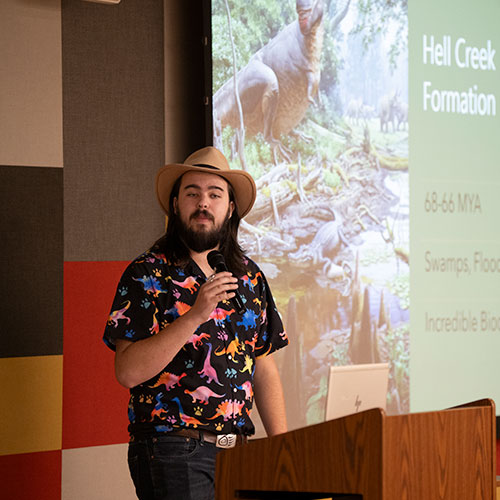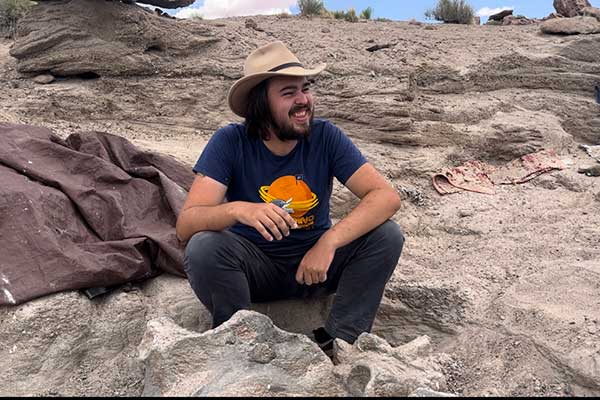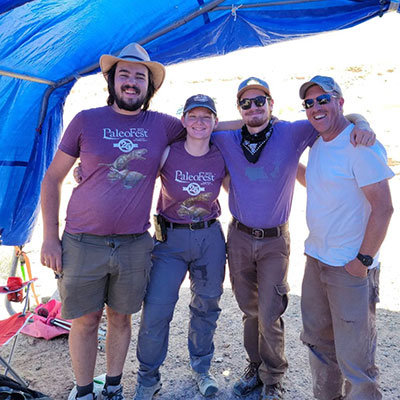
Wooster geology major excavates new insights from dinosaur teeth

For 120 years, researchers have studied dinosaur skeletons in the Hell Creek Formation, an iconic Late Cretaceous formation that spans throughout Montana, Wyoming, and the Dakotas. The College of Wooster geology major Hudson Davis ’24 wanted to examine dinosaur teeth from an understudied section in Carter County, Montana, to find out what information we can gain from the teeth compared to skeletal remains. He took part in an excavation with the Burpee Museum of Natural History, then studied and identified more than 1,500 teeth in the Burpee collection that were excavated between 2001 and 2011.
“I was able to study one of the world’s most famous dinosaur formations with 66- to 68-million-year-old rocks. I believe this was Wooster’s first Independent Study focused on dinosaurs.”
—Hudson Davis ’24
Davis leveraged a series of internship opportunities he completed through Wooster APEX Fellowship program with the Burpee Museum of Natural History and the connections he formed with his colleagues at the museum to build the data set for his Independent Study and reveal an exciting data point for tracking dinosaur species populations. He worked closely with faculty mentor, Mark Wilson, Lewis M. and Marian Senter Nixon Professor of Natural Sciences.
Q: What excites you about your I.S.?

Hudson Davis ’24 completed field work with the Burpee Museum of Natural History, where he was able to help excavate dinosaurs bones, such as the sauropod hip seen here.
Davis: Animals only die once, yet dinosaurs shed teeth throughout their entire life. Tyrannosaurus bones are going to preserve way better than flimsy, hollow Raptor bones. However, teeth are all made of the same material (calcium phosphate) and the preservation biases acting against teeth tend to be similar regardless of species. So I thought teeth might give us a different story about what the ecosystem looked like. Big predators are the rarest in modern ecosystems, so it didn’t make sense that a 40-foot-long, eight-ton killing machine Tyrannosaurus made up 25% of the ecosystem based on skeletal remains. In my teeth study, that number is a much smaller 8%.
Q: How did Wooster prepare you for your project?
Davis: My geology and biology classes acted as the building blocks for my I.S. and changed how I think about science. Specifically, my Paleoecology class probably informed my project and methods, and my Research Skills for Biologists class taught me the necessary statistics to conduct my study. The Earth Sciences Department was incredibly helpful as well during junior I.S. by helping workshop project ideas and giving strategies and support on tackling such a huge project.
Q: In what ways has your relationship with your I.S. mentor supported you throughout this process?
Davis: I first met my advisor Dr. Wilson when I was 12 years old at a natural history museum and my first ever college class was with him. One reason I chose Wooster was to study under him. Dr. Wilson fundamentally changed who I am as a scientist and helped me transition from someone who is interested in and likes science, into thinking and being a scientist. He was there every step of the way to keep me on track and dive deeper into my project. I have struggled with procrastination my entire life, but with

Davis met a variety of new people in the field while working with the Burpee Museum, including Makayla Palm, Stew Cook, and Josh Mathews, pictured here.
his help, I ended up beating that habit and getting button No. 9 at turn-in.
Q: What has I.S. taught you?
Davis: I.S. not only taught me a lot about the Hell Creek Formation and identifying dinosaur teeth but also a lot about myself and how to be a scientist. I worked on this project using collection specimens from the Burpee Museum of Natural History, so I learned a lot about working within collections. After I left Burpee, managing communications about specimens and data long distance was a fun challenge. I also discovered how much I love doing research, which has me rethinking what direction I want to go within paleontology.
Q: What’s next for you after Wooster?
Davis: Two days after graduation, I began working at the Mammoth Site in South Dakota. Following my summer with them, I am taking a year off and working before pursuing a master’s to continue my journey in paleontology.
Featured Image: Davis presented his findings with the College community at the 2024 I.S. symposium.
Posted in Independent Study on May 15, 2024.
Related Posts
Related Areas of Study
Geology
Start research in your first year and graduate with a strong foundation in the Earth Sciences.
Major MinorEnvironmental Geoscience
Investigate the impact humans have on the Earth and research ways to solve pressing environmental problems.
Major Minor

